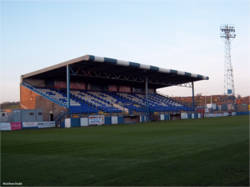Holker Street
| Furness Building Society Stadium | |
 |
|
| Location | Barrow-in-Furness, Cumbria |
|---|---|
| Coordinates | 54°7′24″N 3°14′6″W / 54.12333°N 3.23500°WCoordinates: 54°7′24″N 3°14′6″W / 54.12333°N 3.23500°W |
| Owner | Barrow A.F.C. |
| Capacity | 4,414 |
| Record attendance | 16,874 |
| Surface | Grass |
| Opened | c. 1909 |
| Tenants | |
| Barrow A.F.C. | |
Holker Street, also known as the Furness Building Society Stadium for sponsorship purposes, is a sports stadium located in Barrow-in-Furness, Cumbria, England. Currently and originally used as a football ground, it has also previously been used for speedways races. In addition, the ground also previously had some leisure centre facilities, including four squash courts which have now been demolished. Its current owners and tenants for the vast majority of its history are Barrow A.F.C., who have played at the ground since 1909. Despite having a present capacity of 5,000, some 16,874 people crammed the stadium in January 1954 when Barrow played Swansea Town in the FA Cup third round.
The current site of Holker Street was previously land owned by the Furness Railway, who had used the land as a rubbish tip. It had been converted into a football pitch by Hindpool Athletic football club, though no stands had been built and the pitch had little grass; indeed, pieces of refuse which had been left on the site remained an obstacle for many years after the ground had been developed.Barrow, who had been founded in 1901 and had spent eight seasons playing at a variety of grounds in Barrow, moved in and took a five-year rent from Furness Railway in 1909. The first game played by Barrow at the ground was in the Lancashire Combination league match against Eccles Borough. The game finished in a 5–2 victory for Barrow.
The first structure built at the ground was a wooden all-seater stand in 1912. By 1921, when Barrow were elected into the new Third Division (North) of the Football League, Holker Street had been developed into an "excellent ground" with fully covered terracing surrounding the three remaining sides, changing rooms and turnstiles. The first match at this level was against , with an attendance of 9,750.
...
Wikipedia
